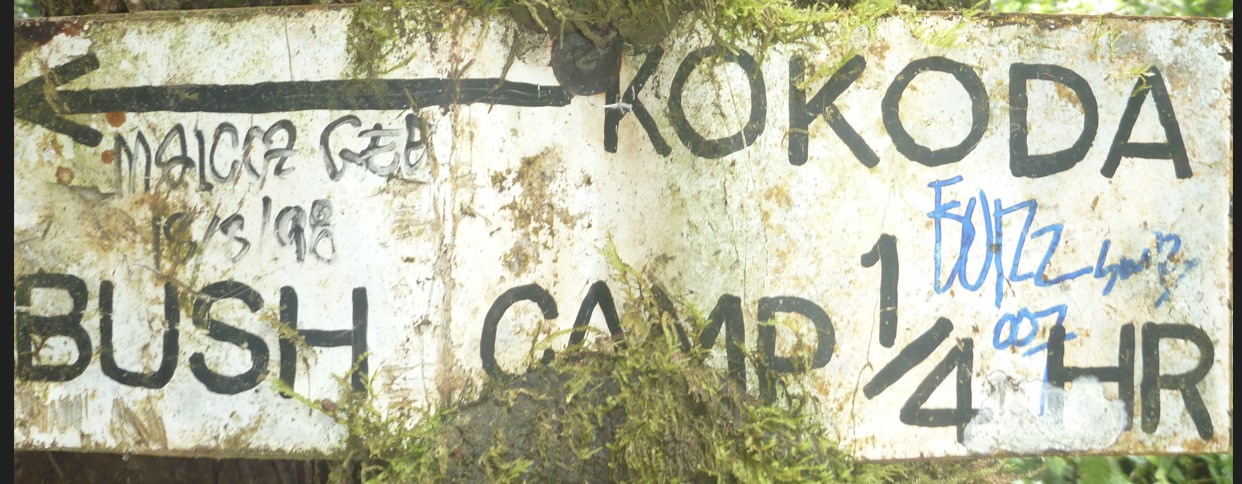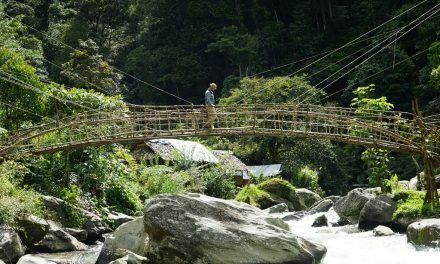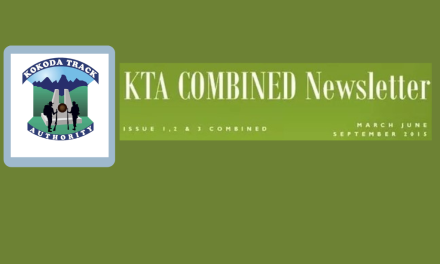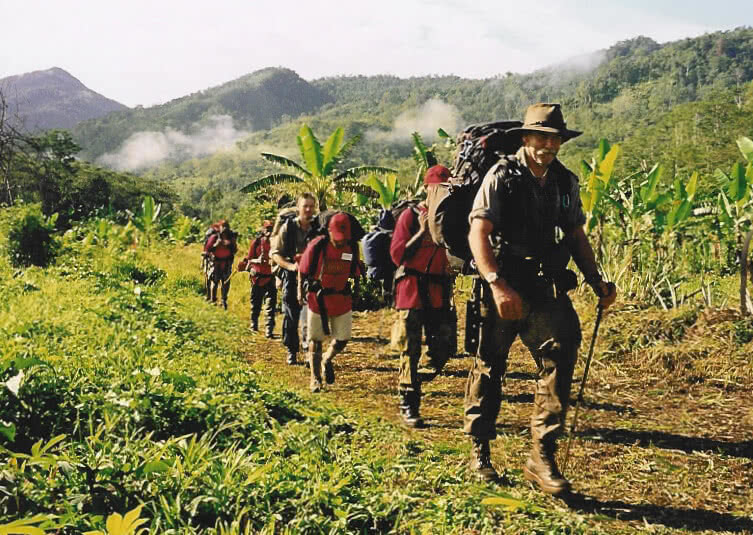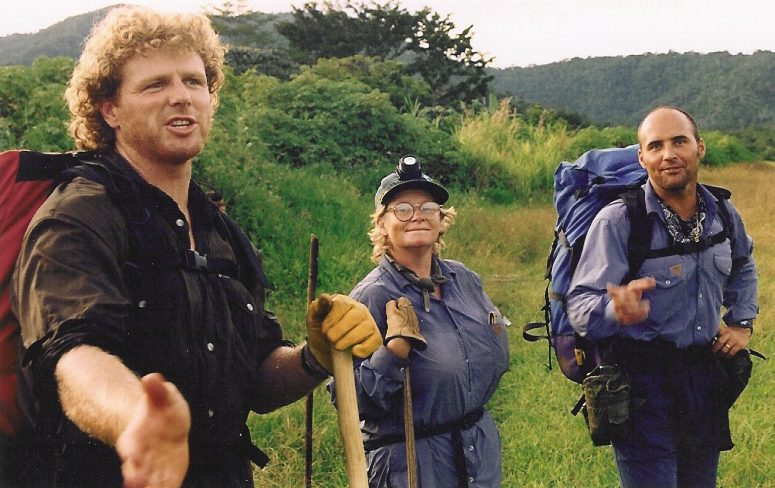Key Facts:
1992:
Fewer than 100 Australians trekked Kokoda prior to 1992 – zero income generated for local subsistence villagers.
2008:
5,621 Australians trekked Kokoda – generating approximately $3 million (K7.8 million) directly into village economies in the form of wages, campsite fees, village purchases – the Kokoda Trail emerged as PNGs most popular tourism destination
2009 – 2024:
Canberra assumed control of the Kokoda Trail under a Joint Agreement signed with PNG in 2008 – since then trekker numbers have plummeted by 42% due to Canberra’s insistence it be managed as an aid-funded environment park rather than as a pilgrimage tourism enterprise.
Preamble
Interest in the Kokoda Trail lay dormant for 50 years until Paul Keating became the first Australian Prime Minister to visit the area since the Kokoda campaign in 1942 – it was heightened with the opening of a significant memorial by Prime Ministers’ John Howard and Sir Michael Somare on the 60th anniversary of the battle of Isurava in 2002.
During these two anniversaries the Minister for Tourism, Arts and Culture provided oversight of the developing pilgrimage tourism industry.
The Minister for Provincial and Local Level Government assumed responsibility for the management of the Trail with the establishment of the Kokoda Track (Special Purpose) Authority (KTA) in 2004. The Board he appointed did not have any expertise in commercial management, pilgrimage tourism, or military heritage. It was soon corrupted as Governors ans Ward Councillors intervened to divert revenue streams for their own benefit.
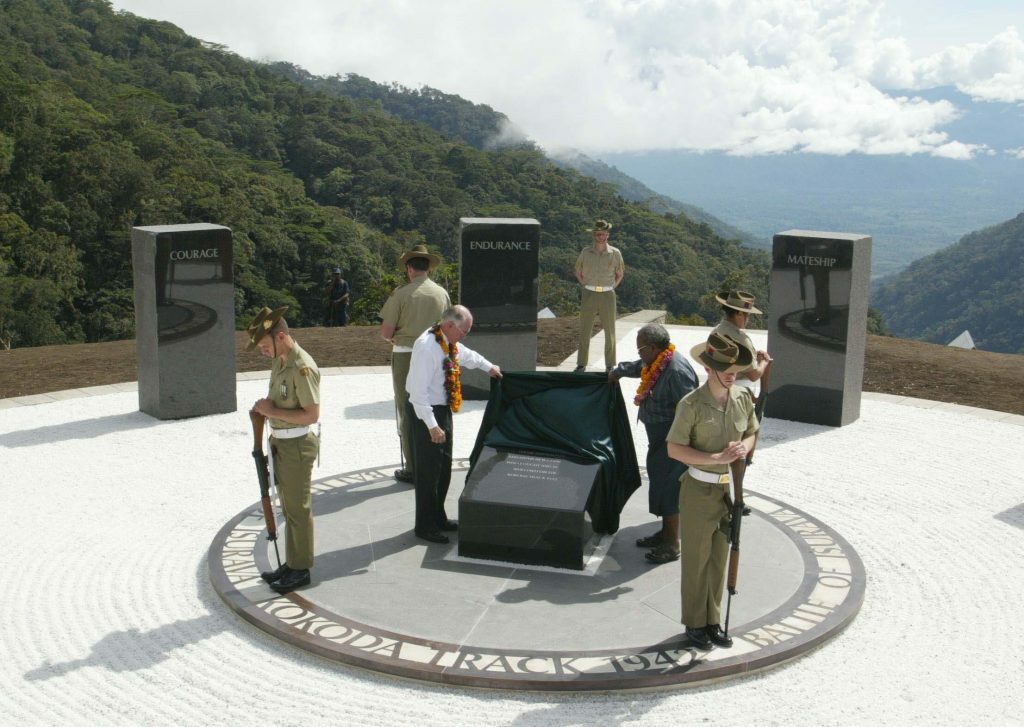
A proposal to establish an $8 billion (PNGK28 billion) gold and copper mine adjacent to the southern section of the trail in 2006 saw the Australian Government react by establishing a Joint Understanding with the PNG Government to develop a case for a World Heritage Listing for the Kokoda Trail and Owen Stanley Ranges. The agreement was framed around the need to protect the Brown River water catchment area on the Trail as a possible water and hydro source for Port Moresby.
Responsibility was allocated to the Department of Environment, Water Heritage and the Arts (DEWHA) due to its responsibility for our Register of Overseas Heritage Sites and World Heritage listings. ‘Heritage’ was later removed when it was rebadged to ias the Department of Water, Sustainability, Energy, Population and Communities (DWSEPC).
For some inexplicable reason the Department of Veterans Affairs (DVA) – which is the custodian of our wartime heritage via its agencies – the Australian War Memorial (AWM) and Office of Australian War Graves – was not included in the Joint Understanding.
Australiane environment officials assumed control of the Kokoda Trail in 2009. For reasons unknown Canberra established two entities responsibile for the Kokoda Trail – a ‘Kokoda Development Program’ under AusAID to deliver aid projects across the Trail, and a ‘Kokoda Initiative’ under DFAT to seek a World Heritage listing. Neither one engaged with either of the two stakeholders involved in the pilgrimage tourism i.e., Kokoda tour operators who generated the income for the industry or villagers who owned the land sacred to our shared military heritage.
The DFAT ‘Strategic Advisor’ for the Kokoda Initiative, who was appointed by DEWHA in 2011, worked directly for the Minister for Environment, Conservation and Climate Change from his office in the Conservation Environment Protection Authority. In 2013 he was appointed Secretary of a ‘Kokoda Initiative Committee (KIC) established by his Minister. This effectively made him the most influential government player within the
The two organizations were amalgamated in 2014 but it made little difference as the same environment-aid officials were retained to pursue the same objectives – for reasons unknown considerations relating to the military heritage of the Trail continued to be ignored.
His influence was increased the following year when the Australian Government absorbed the Aus AID program withing the Kokoda Initiative.
During this time the gazetted area of the Kokoda Trail was rebadged as a ‘Kokoda Corridor’ and later as a
Since then the Kokoda Trail has been managed as an environment park by an aid-funded Government bureaucracy rather than as a commercial tourism enterprise for the economic benefit of traditional landowner communities – the military heritage of the trail was relegated.
Chronology of Facts

Kokoda Track Authority Kokoda Trail Trekker Statistics: 2001-2023
1992-1994
- In the decades since the war fewer than 100 hardy trekkers crossed the Kokoda Trail each year – the combined annual income of all subsistence villages along the Trail was estimated to be in the region of K60,000 in the 1990s.
- The Department of Veterans Affairs had never developed a Military Heritage Master Plan to ensure significant battlesites were identified, interpreted, and protected.
- Charlie Lynn rediscovered the Brigade Hill battle site which had been bypassed and reclaimed by the jungle after the war.
- Link:
- Proposal for a Master Plan to develop the Kokoda Trail as a National Memorial Park
- Canberra’s apathy towards Kokoda: 1992-2002
1996:
- Charlie Lynn rediscovered the original Isurava battlesite which had been bypassed and reclaimed by the jungle after the war.
2001
- Media interest in the 50th and 60th anniversaries of the Kokoda campaign resulted a a dramatic increase in the number of Australian trekkers from 76 in 2001 to a peak of 5,621 in 2008.
2002:
- Prime Ministers’ John Howard and Sir Michael Somare officially open the Isurave Memorial on the 60th anniversary of the battle.
- Link:
- Isurava – The Last Parade
2003:
- Adventure Kokoda established a Kokoda Track Foundation to develop a Strategic Plan for the Kokoda Trail and to provide philanthropic support for subsistence village communities across it.
- Link:
- The Kokoda Track Foundation: 2003-2006
2004
- The PNG Government established the Kokoda Track (Special Purpose) Authority[i] (KTA) as a statutory body for the Kokoda and Koiari Rural Local-level Governments.
- The primary role of the KTA was to manage the emerging trekking industry to ensure villages along the trail received a fair share of benefits from it.
- Warren Bartlett, a former Kiap living in PNG, was appointed CEO on a salary of $12,500 (PNGK25,000) – a part-time assistant was also engaged.
- The Kokoda Track Foundation conducts the first ever village-based workshop at Efogi Village
- Link:
- Record of the conduct of the first village-based workshop conducted across the Kokoda Trail
2005:
2006:
- A proposal to mine the US$8 billion gold and copper deposit on the southern section of the Trail resulted in an Australian Government offer to assist the PNG Government develop a case for a World Heritage listing for the Owen Stanley Ranges.
- Link:
- A Proposal for Kokoda Day to honour the legacy of PNGs wartime carriers
2007:
- The Department of Environment and Heritage (DEH) reorganised as the Department of Environment and Water Resources (DEWR).
- Environment officials and advisors dispatched to PNG to familiarise themselves with the task of achieving a World Heritage listing for the Kokoda Trail and Owen Stanley Ranges.
- They were followed by a conga-line of consultants to advise Canberra on management, social, cultural, and environment issues along the Trail – numerous stakeholder forums were conducted in Australia and PNG.
- For reasons known only to environment officials they did not conduct any village-based workshops/forums with landowner communities across the Kokoda Trail to allow for direct consultation with their communities. Advice provided by experienced Kokoda tour operators who had been engaged with villagers for almost two decades before their arrival was ignored.
2008:
- The Kokoda Trail emerged as PNGs most popular tourism destination
- The Department of Environment and Water Resources was reorganised as the Department of Environment, Water, Heritage, and Arts (DEWHA).
- This created a departmental anomaly with DVA-DFAT allocated responsibility for Australia’s WW1 heritage at Gallipoli and the Western Front, while DEWHA-DFAT was responsible for our WW11 heritage at Kokoda and the Pacific.
- A Joint Understanding relating to ‘the sustainable development of communities along the Kokoda Track corridor, and protection and sustainable use of natural and cultural resources of the broader Owen Stanley region’ was signed by both government Environment Ministers in Madang on 23 April 2008.
- Military heritage is not a consideration for a World Heritage listing so it did not rate a mention in the Joint Understanding which noted that ‘The Owen Stanley Ranges are one of PNG’s major carbon stores and will be assessed along with other locations as potential sites for demonstration Reduced Emissions from Deforestation and Degradation (REDD) activities within the Papua New Guinea-Australia Forest Carbon Partnership’.
- DEWHA1F[i] assumed responsibility for the management of the Kokoda Trail – an Australian official, without any prior experience in PNG, was appointed CEO with a multimillion-dollar aid budget and a 10-fold increase in staff.
2009:
- Responsibility for development along the Kokoda Trail was divided between AusAID, which initiated a ‘Kokoda Development Program’, and DEWHA which initiated a ‘Kokoda Initiative’. Both programs were focused on Kokoda but there was little coordination as they were responsible to different Canberra departments. Neither organisation saw fit to consult with local villagers nor experienced Kokoda tour operators – there was little evidence of them consulting with each other!
- Soon after a $1.5 million (K3.9 million) ‘Village Livelihoods Project’ conceived by DEWHA in Canberra, without any consultation with the PNG Department of Community Development or Kokoda tour operators was imposed on the Kokoda Track Authority with the aim of assisting local villagers to earn additional income from trekkers. The program failed because the proponents had no understanding of the need for tour groups to be self-sufficient regarding the provision of food for their groups and the unreliability of village support.
- No additional income was earned by villagers and no additional crops were produced from local gardens to meet trekkers needs – when the failures became apparent the program was quietly shelved.
- DEWHA officials then extended the definition of the Kokoda Trail to the ‘Kokoda Track Corridor’ – and later to the ‘Kokoda Track Region’ which then included areas further afield such as Sirinumu Dam on the South Coast and the beach-heads of Buna and Gona on the North Coast. This subtle rebadging provided a smorgasbord of opportunity for Canberra based officials, academics and consultants involved in anthropology, archeology, social mapping, gender equity studies, capacity building, mentoring, and social inclusion.
2010:
- DEWHA was rebadged as the Department of Sustainability, Environment, Water, Population, and Communities (DSEWPC). ‘Heritage’ was removed from their title however the role of environment officials in PNG was not affected.
2011:
Mark Nizette, Assistant Secretary for International Heritage at the Department of Sustainability, Environment, Water, Population and Communities (DSEWPC) in Canberra was assigned as a ‘Management Advisor’ to the PNG Department of Environment and Conservation in August 2011 and embedded within the Conservation Environment Protection Authority (CEPA).
2012:
A Strategic Plan2F[i] was developed by Port Moresby based DSEWPC officials for the period 2012 – 2015 was developed without consultation with experienced Kokoda trek operators – it comprised 5 strategies and 33 objectives.
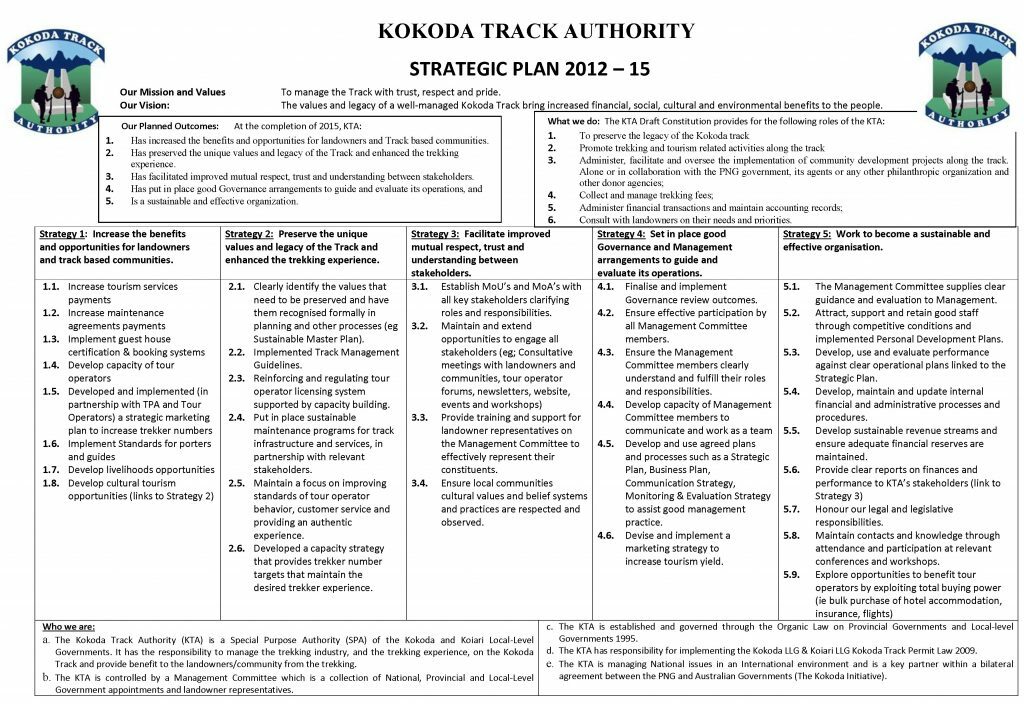
Not one of the 5 strategies or any of the 33 objectives was achieved! No follow-up strategic plan has been developed since then – nobody was held accountable, and plan was quietly shelved.
- DSEWPC transferred responsibility for the management of the trail to the PNG Department of Conservation, Environment and Climate Change without having developed a single management protocol. No legislation had been developed. No local landowner groups had been incorporated. No dispute resolution mechanisms had been put in place. No due diligence systems were introduced for licensing Kokoda tour companies. No village workshops had been conducted. Not a single campsite was certified. Not a single toilet along the entire 138 km trail met the most basic of hygiene standards. No audited financial reports were ever published. No campsite booking system or trek itinerary management systems were introduced.
- Trekker numbers and income earning opportunities for local village communities declined significantly as a result of these management deficiencies under their watch.
- Links:
- The Rod Hillman Era of Mismanagement: 2009-2012
- Kokoda – Time for a Rethink
- Kokoda – Beyond the Legend
2013:
2014:
- DSEWPC was reorganised into the Department of Heritage and Water (DHW) and later as the Department of Environment (DoE) with the election of the Coalition Government.
- The ‘Kokoda Development Program’ and the ‘Kokoda Initiative’ were amalgamated within DFAT PNG under the watch of the Minister for International Aid and the Pacific. There were no staff changes – environment officials recruited by DEWHA/DSEWPC/DHW continued in their roles in pursuit of a World Heritage listing for the Kokoda Trail without interruption.
- DFAT Kokoda Initiative Strategic Advisor, Mark Nizette, was declared ‘persona non grata’ in the Kokoda Track Authority (KTA) office by the PNG CEO, James Enage.
2015:
- Australian World Heritage expert, Dr Peter Hitchcock AM exposed the fallacy of achieving a World Heritage Listing3F[i]: ‘Given the on-going threat to heritage values by mining and other development activities, no part of the Kokoda Track and Owen Stanley Ranges Tentative Listed area should be considered for formal nomination as a World Heritage area until such time as an adequate extent of high value areas is formally protected. Given this prerequisite, it may be years before a suitable tract of land is protected and worth considering for World Heritage nomination.’
- Environment-DFAT produced a ‘Master Plan for the Kokoda Trail’ based on three pillars: The Track – The People – The Environment.4F[ii] – ‘Pilgrimage’, which is the primary motivation for Australians to trek across it, was excluded from their plan.
- Military heritage was further devalued with the word ‘mateship’ being replaced with ‘friendship’ in the official agreement for the Kokoda Trail between Australia and PNG5F[iii].
- Links:
- The fallacy of World Heritage for the Kokoda Trail
- Adventure Kokoda Review of the Kokoda Initiative Master Plan
- Kokoda Trail Management: The Way Ahead
- Parliamentary speeches re the Kokoda Trail by the Hon Charlie Lynn MLC 1998-2015
2016:
- Links:
- My 1991 Kokoda reconnaissance
- Adventure Kokoda Response to the Mid-Term Review of the Kokoda Initiative 2nd Joint Understanding
- Call for a Visitors Centre at Owers Corner
2017:
- The PNG Government announced a K600 million Edevu Hydro Project on the Brown River6F[i] to meet the future water and power needs for Port Moresby. The project, developed by the China Gezhouba Group Corporation and the East Vision Group, was scheduled for completion in 2020.
- The Edevu Hydro Project has negated the need for a World Heritage listing to protect the Brown River Catchment Area.
- The PNG Prime Minister Peter O’Neill ordered a review of the KTA due to the dysfunction of the management systems put in place by DEWHA/DSEWPC/DWH/DoE/DEE officials.
2018:
- DFAT-Kokoda Initiative used the cover of the Christmas-New Year holiday period to employ an American anthropologist without any or previous army service or military history qualifications as Australia’s ‘National Military History Advisor’ via a process that would attract the attention of a corruption watchdog if it happened in Australia – see link below.
- DFAT-Kokoda Initiate ‘facilitated’ a ‘lateral promotion’ for the KTA CEO, James Enage to the National Capital District Commission.
- Deputy Secretary of the Department of Provincial and Local Level Government Affairs (DPLLGA) Mr. Julius Wargirai, seconded by the DFAT Strategic Advisor, Mark Nizette, to replace Enage in an ‘acting’ capacity – Wargirai had no qualifications or experience in commercial business management, pilgrimage tourism or trekking.
- DFAT Kokoda Initiative Strategic Advisor, Mark Nizette, moved back into the KTA office – reported to have advised Wargari that he was to site all documention into and out of the office.
- Links:
- Call for investigation into the recruiting process for the engagement of a National Military Heritage Advisor for PNG]
- Adventure Kokoda response to the Kokoda Initiative National Military Heritage Plan for the Kokoda Trail
- Response to the 2018 KTA Review by Tourism Recreation Conservation consultants
- Kokoda Tour Operators Association – Shameless Australian Lobby Group
2019:
- Soon after Mark Nizette relocated himself back into the KTA office, K350,000 of trek permit fee income was ‘donated’ to an Australian NGO which is not connected to Kokoda tourism. His close friend, Dr Andrew Moutu, Director of the National Museum & Art Gallery, was also a director of the Australian NGO – neither Nizette nor Dr Moutu declared a conflict of interest.
- The CEO of the Australian NGO, Dr Genevieve Nelson, was also a close friend of Mark Nizette – no conflict of interest was declared.
- Nizette claimed this was ‘undispersed income‘ however nobody knew what the financial situation of the KTA was at the time because it has never published an Annual Financial Report since the DFAT Kokoda Initiative assumed responsibility for the management of the Kokoda Trail in 2009.
- When Julius Wargirai was challenged about the donation he advised that when he was seconded as CEO of the KTA in November 2018 there was no money in the KTA account and he had to seek financial support from other Government departments.
- There is therefore a need for an investigation into who is telling the truth, Mark Nizette or Julius Wargirai?
- Mark Nizette’s 2019 Annual Report of Environment-DFAT PNG7F[i] focused on issues relating to gender equity, access for people with disabilities, and social inclusion along the trail – there is no mention of the need for a Military Heritage Master Plan or sustainable economic development for local villagers.
- COVID-19 resulted in the shutdown of Kokoda tourism and the evacuation of Australian officials from PNG.
- No financial reserves had been established to support local villagers engaged in Kokoda tourism in the event of an emergency during the period 2009-2019.
- No financial reports were ever published by the KTA under Canberra’s watch which is a breach of the PNG Public Service Act.
- No plans were established to provide villagers with interim employment opportunities re the siting and development of campsites and trail maintenance to meet new social distancing and hygiene criteria expected to apply post Covid-19.
- No action was initiated to identify traditional landowners or to establish Incorporated Landowner Groups (ILGs) across the trail as a means of transferring ownership of Kokoda tourism to them.
- The Covid pandemic caused trekking to cease and exposed the flaws of a management system which made no provision for any sort of contingency to assist villager communities.
- Links:
- 2019 Kokoda Initiative Annual Report – A betrayal of our Kokoda legacy
- Adventure Kokoda response to the Kokoda Track Authority Forum held in Port Moresby, 8 March 2019
2020:
- DFAT Strategic Advisor, Mark Nizette, used the cover of Covid to draft a proposed ‘Kokoda Track Management Authority Act’ which would see the Kokoda Trail permanently managed as an environment park by the Conservation Environment Promotion Authority (CEPA) rather than as a tourism enterprise by the Minister for Tourism, Arts and Culture. Nizette did not consult with the Tourism Promotion Authority; traditional landowner communities across the Trail; or Kokoda tour companies who generate the income for Kokoda tourism in the drafting process of his propsed bill. A review of the consequences of the proposed legislation can be found on this link:
- Links:
- Network Kokoda ‘For Valour’ speech by Charlie Lynn
- The Kokoda Trail: Environment Vs Tourism
- Adventure Kokoda response to the Mid-Term Review of the Kokoda Initiative Second Joint Understanding
- Review of the Kokoda Initiative 2017-2020 Review by Oxford Policy Management
- New Kokoda Management Bill – A suicide note for Kokoda Tourism!
- Marketing strategy for Kokoda pilgrimage tourism
- Funding proposal for a Military Heritage Interpretation Plan for the Kokoda Trail
2021:
An exposè by PNG blogs on this link on 25 March 2021 revealed:
‘His (Minister for Environment, Conservation and Climate Change) Department of Environment and Conservation (DEC) changed to the Conservation and Environmental Protection Agency (CEPA), which is alleged to have been established to assist a mafia-style network to suck up public money under the management of former Environment & Conservation Secretary Wari Iamo, indisputably the most corrupt official that DEC has ever hosted. Current Secretary Gunther Joku, brother of the infamous West Papuan Franzalbert Joku who had his own lengthy time milking government funds into his personal pocket, is collaborator with Dr Wari Iamo, along with their Australian friend and strategist Andrew Taplin. More than K3 million was budgeted for the DEC to CEPA transition, now how could it cost this much and where did the money disappear to? Minister Pundari should know. The money was raised internally by transferring money from one account to another especially from the funds allocated under developmental (PIP) budgets, projects undertaken through joint-bilateral agreements like Kokoda Track Initiatives and Coral Triangle Initiatives (CTI), and further purged from the recurrent budgets. Minister Pundari signed off on all this.
Related Links:
- Links:
- The problem with PNG – Too many fake Knights
- Official name of the Kokoda Trail
- Owers Corner – Neglected gateway to the Kokoda Trail
2022:
- Kokoda Trail reopened after the Covid pandemic – tour companies discovered that no assistance had been provided by the KTA to ensure campsites would be restored and the Trail would be safe.
- Links:
- Papua New Guinea – A Place of Pilgrimage
- Updated Proposal for Kokoda Day Proclamation
- Kokoda: Conflict between the management theory and reality in a Melansian context
2023:
- Julius Wargirai, retained by the DFAT Kokoda Initiative in an ‘Acting’ capacity as CEO of the KTA refuses to provide an assurance the Kokoda Trail is safe and campsites are adequate – also refuses to publish an Annual Financial Report even though he had not had to manage any trekkers over the previous three years due to the Covid pandemic.
- Adventure Kokoda advises Wargirai they would prefer to pay campsite owners direct to give them an incentive to meet the needs of trekkers in the 2023 Anzac trekking period.
- Wargirai demands the company pay the KTA but refuses to give an assurance the Trail will be safe or campsites adequate to meet the needs of trekkers.
- The first Adventure Kokoda groups steps off the Trail without trek permits and advises KTA rangers they will pay an campsite owners directly in cash.
- The following day Adventure Kokoda pays the full amount owing from trek permit fees to the Acting CEO, Julius Wargirai.
- Wargari misleads the Kokoda Initiative Committee by advising that he had not received any cheques for trek permit fees.
- The Kokoda Initiative Committee recommended the Minister for Environment, Conservation and Climate Change to cancel Adventure Kokoda tour operator’s licence.
- Secretary of the Kokoda Initiative Committee, Mark Nizette, neglects to inform the committee of a conflict of interest regarding a pending defamation case he initiated against Charlie Lynn,
- Governor Gary Juffa and Julius Wargirai threaten violence against Adventure Kokoda’s charter airline if they they flew their trekkers into Kokoda – a clear breach of the PNG Ministerial Code of Conduct!
- Adventure Kokoda files an injunction against the cancellation of their tour operator’s license with the PNG National Court.
- PNG National Court restores Adventure Kokoda tour operator’s licence:
- Links:
- Kokoda – A Trail of Woe by Rashmii Bell
- Adventure Kokoda Licence restored by PNG National Court
- PNG National Court Judgement
2024:
- Illegal blockade of the Kokoda Trail by a group of Port Moresby based landonwers at Nauro village over a compensation issue brings the 2024 trekking season to a premature close – traditional landowner communities forfeit up to K2 million in foregone wages, campsite fees local purchas during the peak September-October school holiday period.
- Blockade exposes Government impotence in resolving disputes with landowners – PNGs international reputation as a reliable tourism destination damaged.
Relevant Links:
- Links:
- Network Kokoda: Honouring their legacy across the Kokoda Trail
- Kokoda Tourism – The cost of anarchy!
- Illegal Kokoda Blockade-Timeline and consequences for Kokoda tourism
- Kokoda Blockade – A catalyst for change
- Time for Women to take a lead role in Kokoda Tourism
- Funding proposal for a Kokoda Trail Military Heritage Master Plan
Summary of Management Outcomes for the Kokoda Trail: 2008-2024
- During the period 2004 – 2008, under PNG local management, trekker numbers increased by 255% from 1,584 to 5,621.
- Under Australian Government administration via DEWHA/DSEWPC (2008-2012) trekker numbers fell by 36% from 5,621 to 3,597 despite a 10-fold increase in staff and a multimillion-dollar Aid budget.
- This decline has continued with a further decrease of 16% from 3597 in 2013 to 3033 in 2024.
- There is not a single management protocol in place for the Kokoda tourism industry.
- The overall decline in trekker numbers as a result of the management system put in place by Canberra environment officials in the DFAT Kokoda Initiative has resulted in an estimated loss of some $20 million (K50 million) in tourism revenue for PNG; a loss of 70,000 working days for PNG guides and carriers; and a loss of $580,000 (K1.5 million) for campsite owners along the trail.
Kokoda Trail Military Heritage Factors
- DVA-DFAT is responsible for Australia’s WW1 military heritage at Gallipoli and the Western Front.
- Environment-DFAT PNG is responsible for our WW11 military heritage at Kokoda and the Pacific.
- DVA is responsible for the Australian War Memorial (AWM) which is the custodian of Australia’s military heritage.
- Papua and New Guinea were Australian mandated territories in 1942 and shoulpd therefore be included within DVAs charter.
- For reasons known only to Environment-DFAT officials the AWM has been excluded from the process of developing a Military Heritage Master Plan for the Kokoda Trail over the past 15 years.
- DVA was also excluded from the process of recruiting a National Military Heritage Advisor for DFAT in PNG.
- DFAT PNG advertised the position during the peak Christmas-New Year holiday period from 22 December 2017 – 8 January 2018. The advertisement was restricted to a small number of institutions who were closed during the holiday period – both the AWM and the RSL were excluded from the process of tendering for the position.
- The successful applicant was a PNG based American anthropologist whose thesis for his Doctorate was ‘Ambivalent Empire” Indigenous and Colonial Historicities in the Trobriand Islands, 1832-1941’.
- The American anthropologist had no prior military historical credentials which was evident in his ‘Kokoda Track Military Heritage Management Plan’8F[i] where he stated:
‘The Plan will also recognise the prominent roles of Japan and the USA in PNG’s war history, as well as the place of other nations, including the UK, India, Fiji, China, Korea, Taiwan, etc’.
- Those familiar with our military history are aware that ‘the UK, India, Fiji, China, Korea, Taiwan, etc’ were not involved in the Kokoda campaign or any other campaigns in Papua or New Guinea during the war!
- The plan itself was a paltry 16-page document (with a liberal use of graphics to achieve this) which lacked the detail required of a proper Military Heritage Plan. It provided no comfort that any real outcomes to protect, honour and interpret our wartime heritage across the Kokoda Trail would be achieved via that process.
- It is also worthy of note that Environment-DFAT have failed to develop a single interpretive memorial at any battlesite along the Kokoda Trail since they assumed responsibility for it 15 years ago.
- In early 2021 the Minister for Veterans Affairs accepted a Network Kokoda proposal to develop a Military Heritage Master Plan after Prime Minister Scott Morrison (who trekked across it in 2010) intervened – the DVA Minister then announced a $10 million (K26 million) allocation to commemorate the 80th anniversary of the end of the war in PNG.
- The project was hijacked under the cover of Covid with the funds being directed to a ‘World War Galleries’ project at the National Museum and Art Gallery which has a low visitation rate – those who do visit are motivated by the diverse cultural history of the ‘land of a thousand tribes’.
- The significance of the 80th anniversary of the Kokoda campaign was therefore ignored.
Lest We Forget indeed!
Conclusion
The military heritage of the Kokoda campaign, the physical challenge it presents, and the uncertainly of a journey to the ‘land of the unexpected’ are the prime motivators for Australians to trek across it.
Managing the Kokoda Trail as a government environment park rather than as a tourism enterprise under the watch of the DFAT Kokoda Initiative has clearly failed.
Any taxpaer funds committed to anything associated with a ‘Kokoda Initiative’ should be required to satisfy the following criteria:
1) Will it enhance the military heritage value of the pilgrimage for the paying customers?
2) Will it create an economic opportunity for communities along the Trail?
3) Will it protect the environment?
Unfortunately, the military heritage of the Kokoda Trail has not featured as a priority with the DFAT funded ‘Kokoda Initiative’ since they assumed control of its management in 2009.
So, after 15 years in situ, a plethora of consultants’ reports, and more than $65 million (PNGK167 million) in taxpayer Aid funding there has been no action taken to engage an accredited Military Heritage Architect via the Australian War Memorial to develop a Military Heritage Master Plan for the Kokoda campaign.
Recommendations
- Responsibility for the management of the Kokoda Trail in PNG be transferred from the Minister for Provincial and Local Level Government Affairs (and the influence of the aid-funded Minister for Environment, Conservation and Climate Change) to the Minister for Tourism, Arts and Culture.
- The PNG Government use the relevant provisions of their Lands Act to acquire the gazetted area of the Kokoda Trail as a National Tourism Assett.
- DVA be the lead agency responsible for the protection, development, and interpretation of our military heritage of the Kokoda Trail.
- A Joint Understanding for Commemoration be developed between Australia and PNG to identify, protect, honour and interpret our shared wartime heritage in Papua New Guinea.
- Kokoda Day be proclaimed as a National Day of Commemoration in Australia and Papua New Guinea on the 3rd November each year.
- Links:
- Proposed Joint Agreement for Commoration of our Shared Wartime Heritage between PNG and Australia
- Proposal for proclamation of Kokoda Day
MISMANAGEMENT INDICATORS
PUTRID TOILETS
Landowners across the Trail have never received any training of micro-finance assistance to build hygienic toilets or ablution facilities across the Trail. After 15 years, Port Moresby based, taxpayer-funded Australian environment officials responsible for managing the Trail have elected to ignore this most basic need for trekkers. As a result, many trekkers avoid them and ‘go bush‘ which is the worst of all environmental outcomes.
Feedback from female trekkers re toilets facilities across the Trail:
‘I don’t know how I can be constructive in my criticism here, but the smell was appalling!! I’m sure you have considered it but don’t they use lime or something in the Army which is supposed to help? Other than that they were as expected…. I suppose they were better than having to squat behind a bush, but only marginally’!
‘Ok, they really are they best they can be, and I have seen far worse. I was happy with no seat, but the smell was horrific in some of them. Seriously, it’s a horrible sensation vomiting while having a wee. I quick learnt to avoid the high usage ones. I don’t really see what more you can, other than have them relocated more frequently’.
‘Well each site you could write a story on. The first one I made an attempt but gee whiz it didn’t happen for me, going bush was great, room with a view and fresh. Latrines were good when it was raining’.
‘Ha Ha Ha…. Never lost my stomach contents but it was close…. gagged sometimes….. But it was all about Kokoda. Some of the funniest laughs I had with the girls were standing with a snap lock bag full of Loo paper outside the toilets.. (or smelly hole in the ground) with toilet paper up my nose…. (yes I think I am a princess)’.
I now appreciate a white bowl with flushing water and a button…… The funniest was when Cathy and Nicole had to do a Conga line to get me out of one of them. It’s a girl thing’.
‘It is a third world country.’
‘What else could you expect!’
‘You are in a poor country so I would not expect flushing toilets but some of the sites I think it would be easier to use a shovel’.
‘Some were better than others. Some were downright disgusting. Probably can expect too much more given they are shared with all and sundry’.
‘Like I mentioned, I couldn’t bring myself to use the facilities at Kokoda, due to the smell’
’They weren’t great, I always preferred ‘going bush’, less smell, and more solitude. Not sure if this is something that AK can really improve though’.
There is no excuse for this appalling standard along the trail in view of the fact that the Australian Government has invested $40 million in the Kokoda initiative over the past 5 years.
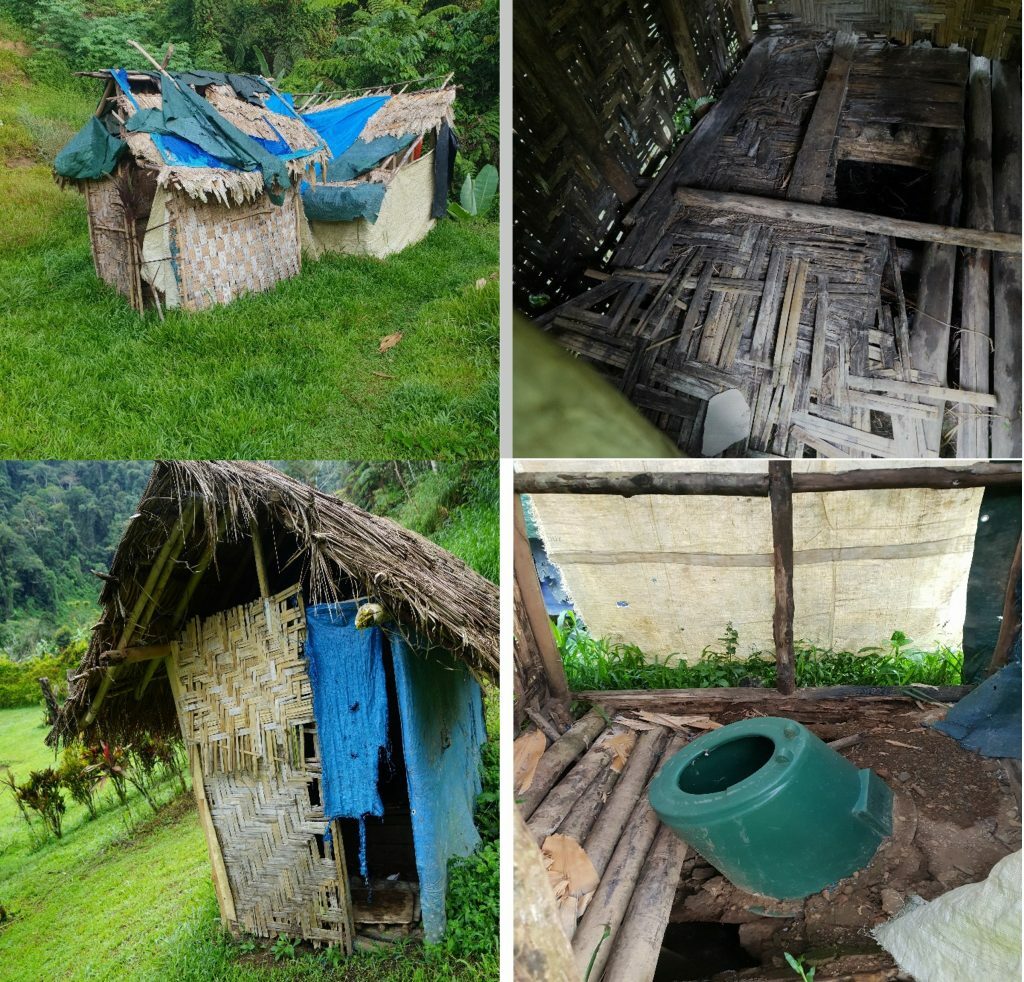
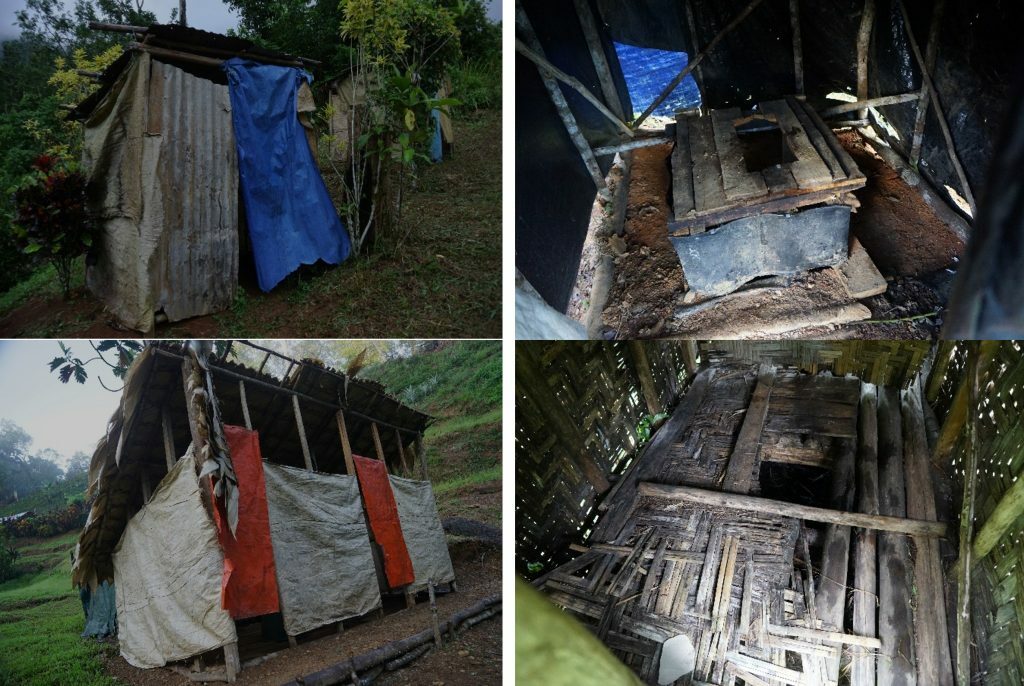
DFAT Kokoda Initiative officials should be called on to explain why they have refused to invest in a single hygienic toilet for trekkers (taxpayers) anywhere across the 138 km Trail over the past 10-years?
UNPLANNED CAMPSITES
The failure to identify landowners and assist them in developing campsites with micro-finance initiatives led to a proliferation of unplanned sites in the hope that they would attract trekkers. When they were not used due to the lack of a trek itinerary management system they were abandoned and left to be reclaimed by the jungle which had been cleared to accommodate them.

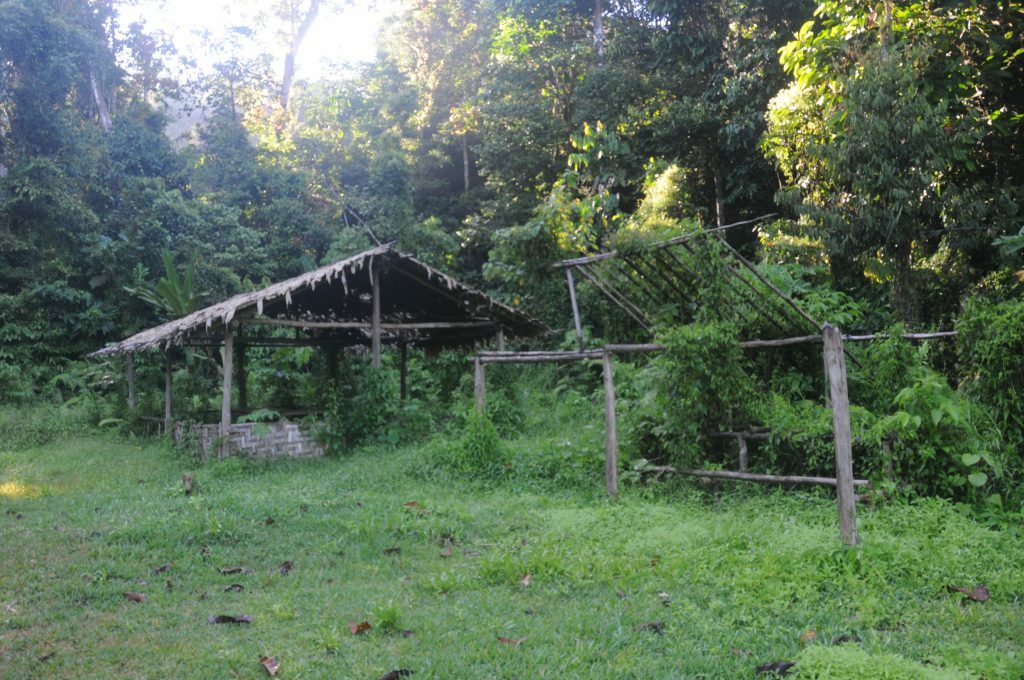
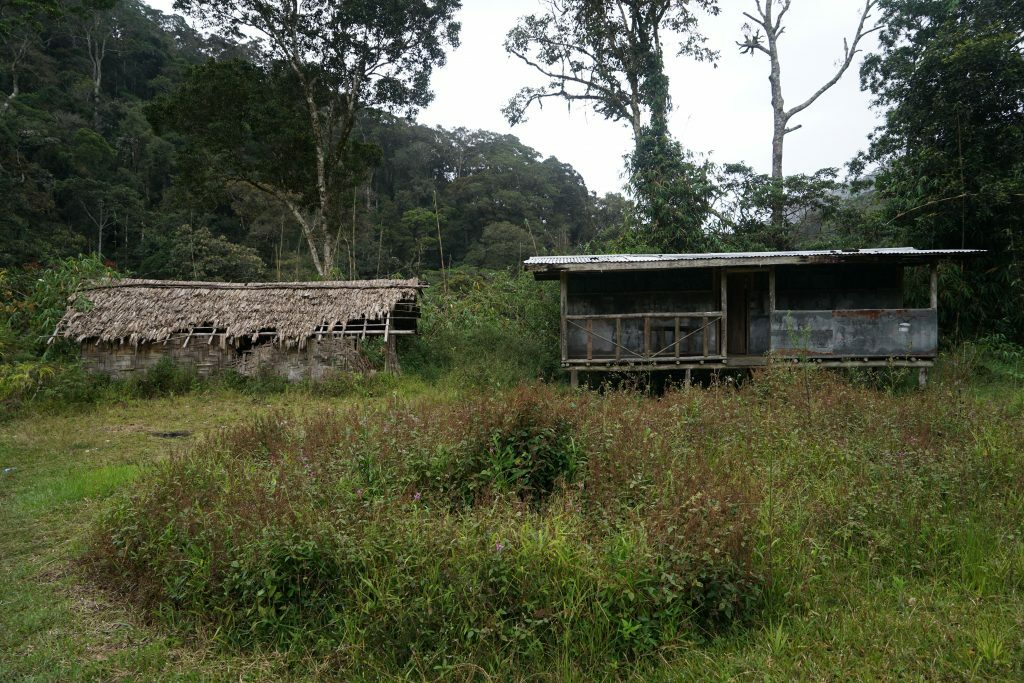


DFAT-Kokoda Initiative officials should be called to account for their failure to develop campsite management-development plan over the past 10 years.
LANDSLIDES
Landslides are common on the northern area of the Trail. Local villagers have adapted to them by re-routing tracks around the affected area for generations. However landslides can take months to address because the deskbound DFAT officials have failed to develop a rapid-reaction maintenance team to ensure safe passage for trekkers.
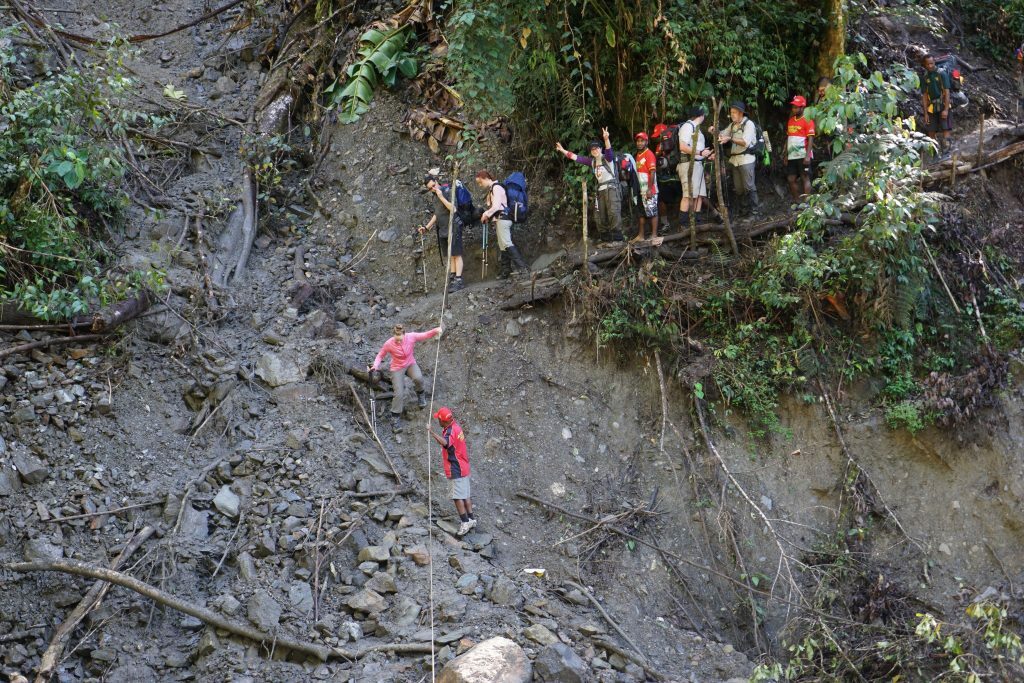
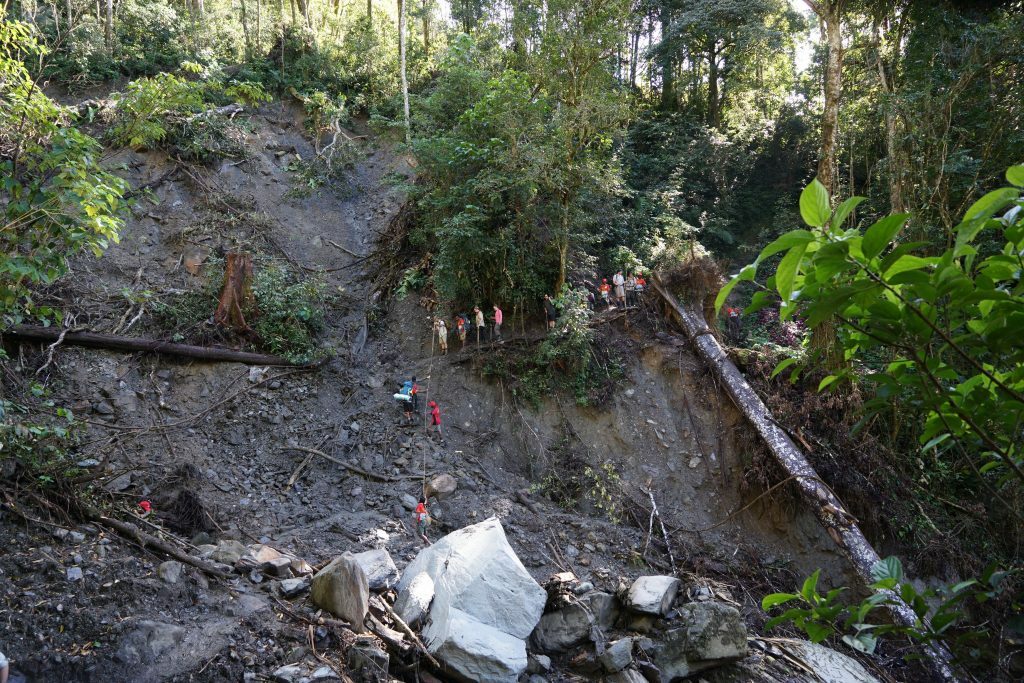
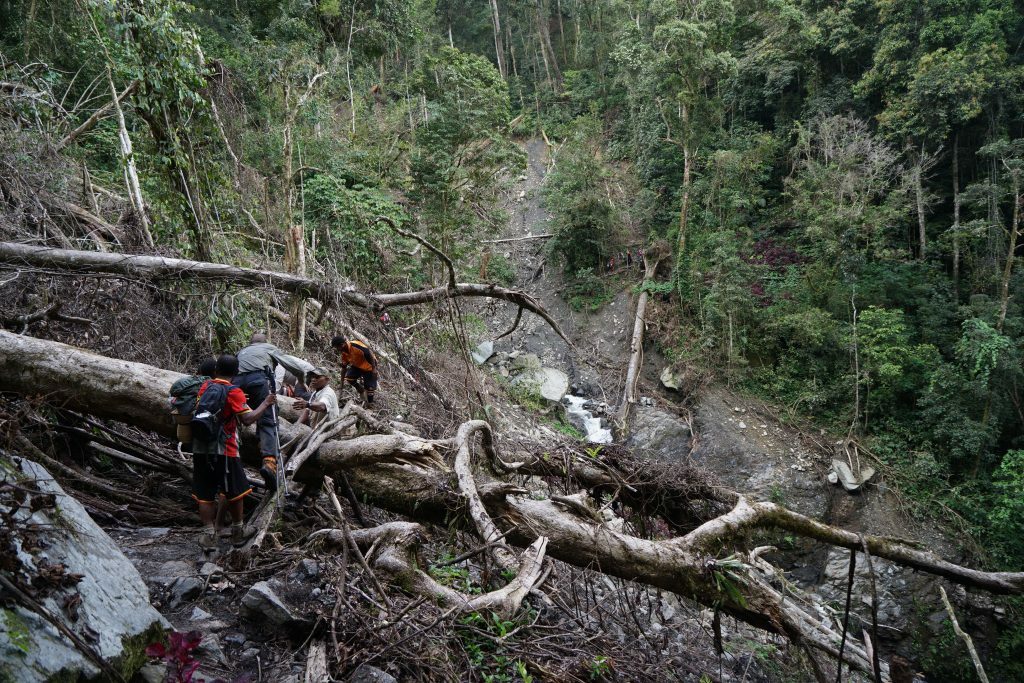
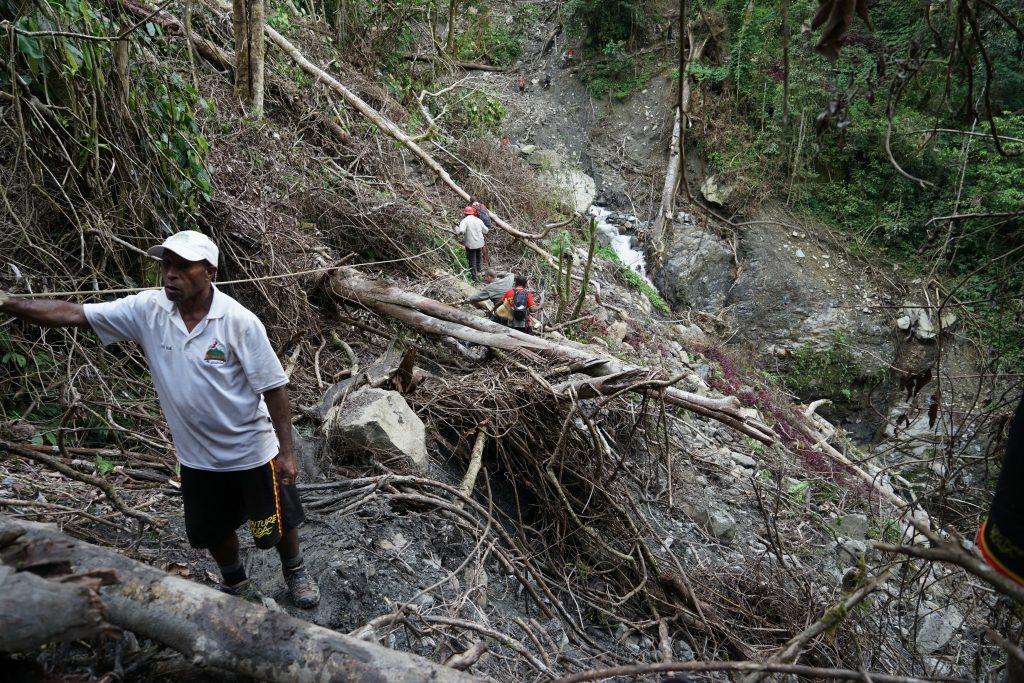
DFAT-Kokoda Initiatives should be called to account to explain their failure to develop village-based ready reaction teams to clear obstacles along the Trail and keep it safe.
PREVENTABLE EROSION
The failure to develop an effective trail maintenance plan is inexcusable. Areas affected by erosion are not easily accessible by helicopter so they are not sighted by deskbound environmental officials. One of the obvious solutions is to employ local landowner groups to cut single-file one-way north-south tracks and south-north tracks in critical areas to allow for regeneration. The management authority has also failed to engage trekking companies to provide environmental feedback to allow them to monitor the situation. The result is a lose-lose situation for the environment and a lose-lose situation for local job opportunities for landowner communities.


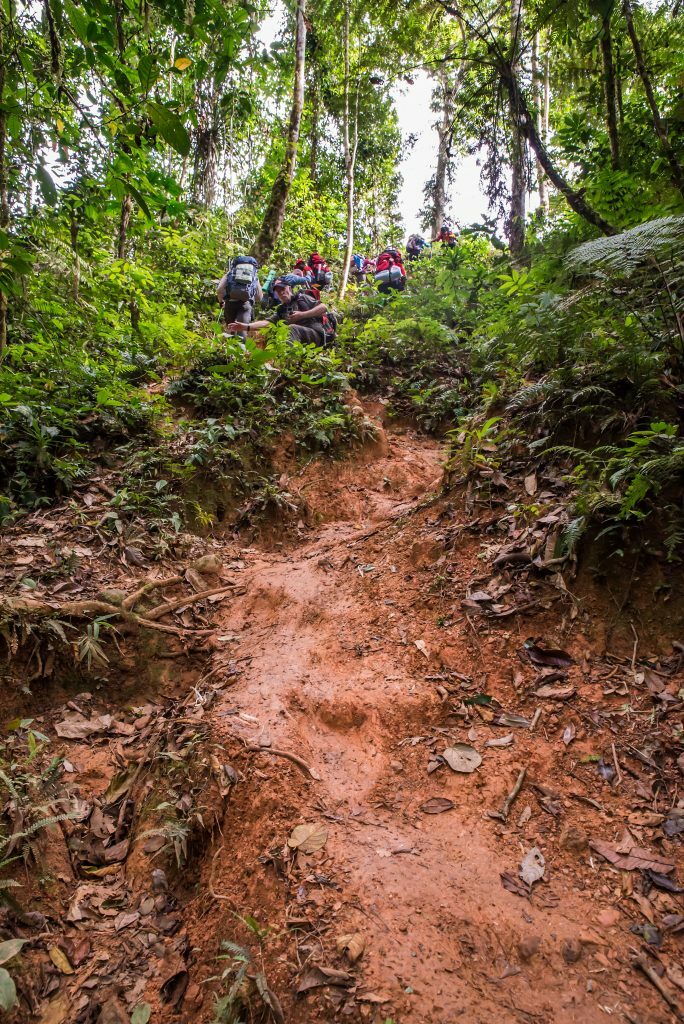

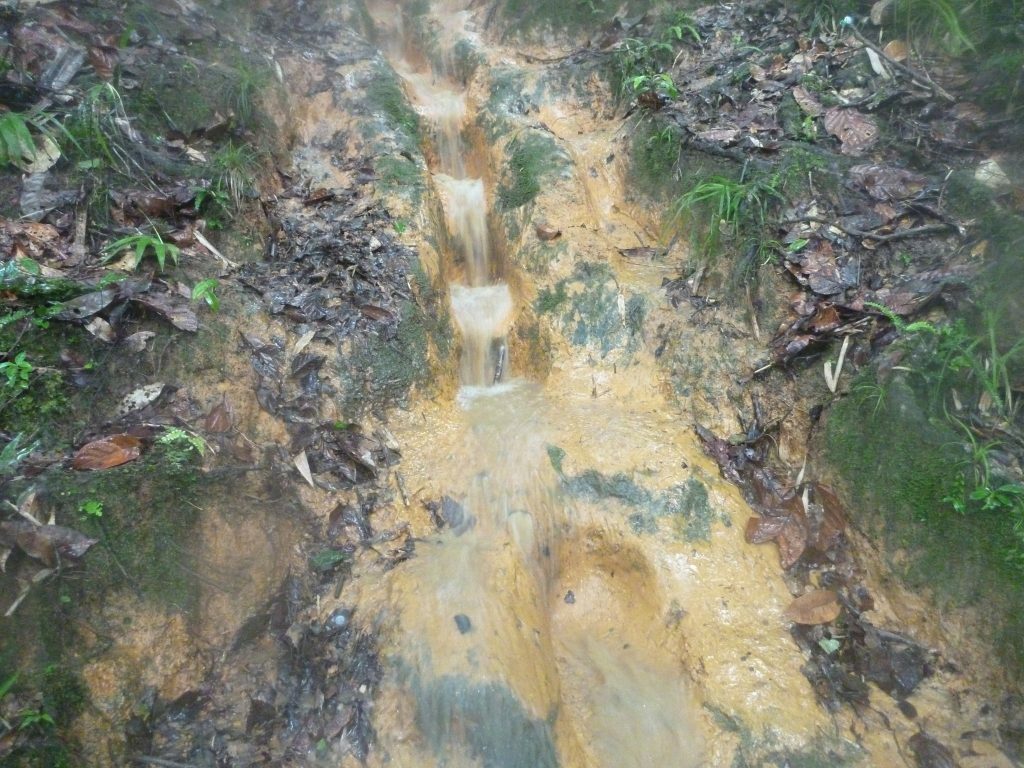

DFAT-Kokoda Initiative officials should be called on to account for their failure to develop a sustainable trail management plan which provides for local villagers to be employed to prevent erosion and why they have failed to engage trekking companies to provide feedback on works needed and works completed.
[i] https://www.academia.edu/37661061/KOKODA_TRACK_Military_Heritage_Management_Plan_Papua_New_Guinea_National_Museum_and_Art_Gallery
[i] 2019 Annual Review Report Papua New Guinea–Australia Governance Partnership Quality and Technical Assurance Group Final Report
[i] https://www.abc.net.au/news/2017-02-06/hydro-project-to-boost-port-moresbys-energy-supply/8245900
[i] https://www.sprep.org/attachments/VirLib/PNG/world-heritage-sites-png.pdf
[ii] Kokoda Initiative Master Plan by Trip Consultants August 2015
[iii] https://www.environment.gov.au/heritage/publications/papua-new-guinea-australia-joint-declaration-preservation-kokoda-track-region
[i] https://blog.kokodatreks.com/2020/03/09/kta-strategic-plan-2012-2015-fail/
[i] ‘Heritage’ was eventually dropped from the Department which was rebadged as the Department for Sustainability, Environment, Water, Population and Communities (DSEWPC)
[i] Special Purpose Authorities are established to serve the interests of landowners of Mining and Petroleum impact project areas. EMTV Report

